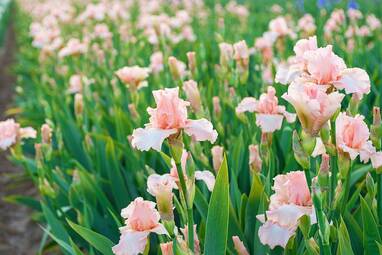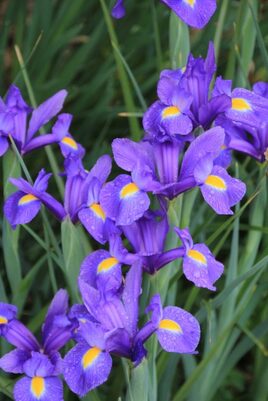|
The National Garden Bureau, the non-profit information and marketing arm of the gardening industry, has chosen the iris as one of this year's "Year of” honors .
For ease of growing, zone hardiness, and strikingly dramatic color in the garden in late spring, you can’t go wrong with iris. Named for the Greek goddess of rainbows, the variety and color of blooms is vast with up to 300 varieties in propagation. Bearded, beardless and Dutch irises are the three main types of iris. My favorite is the old fashioned standard beardless iris my grandmother grew from which my yellow irises originated. But I also love my bearded white irises and of course the violets to deep purples of the Dutch type Russian and Siberian irises. Bearded and beardless Irises grow from rhizomes planted just below the surface, barely covered by soil. Plant in the fall for a good chance at spring blooms. Old rhizomes will sprout new rhizomes from which new plants and blooms will grow. When iris become too densely packed, dig them up, break the new rhizomes off the old and discard the old. You can trim back both the foliage and the roots to about 3 inches or so for easy handling and replanting. Replant the new and expect blooming the next spring. Irises likes full sun to part shade. Plant in well-drained soil. Examine your plants mid-summer to early fall for any sign of iris borers. Withered and premature yellowing of the plants may indicate infestation. I press down on the rhizomes to check for softness. Rhizomes should be firm to the touch. If soft rhizomes are detected, it is best to dig up the plant and discard it checking adjacent plants for signs of softness. If just the old rhizome is affected, break off new rhizomes and replant those. For more information on how to grow irises, the varieties available and the amazing range of colors, check out: https://ngb.org/year-of-the-iris/ http://www.irises.org/gardeners/care-classification/bearded-iris/ https://hort.extension.wisc.edu/articles/iris-borer/ Article by MGV Pam Davies, photos by National Garden Bureau
1 Comment
6/26/2020 05:06:19 am
Hiring a professional company for getting landscaping designs for outside your home is indeed a great idea.
Reply
Leave a Reply. |
|
| North Country MGV | gARDEN bLOGS |
Location |
|


 RSS Feed
RSS Feed